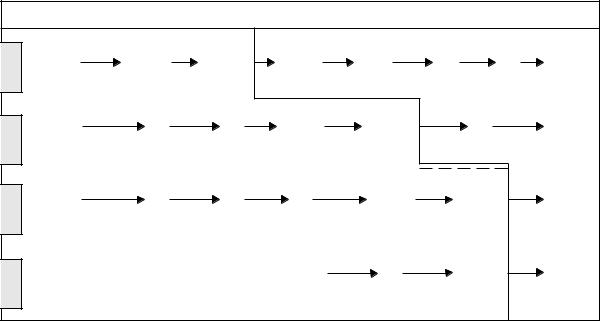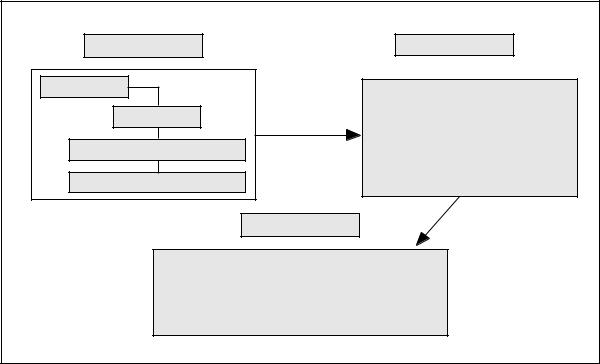
Диплом ИМЭ, ССК / Диплом / diplom / Приложения / HANDBOOK_DOD-Systems-Engineering-Guide-2001-01
.pdf
Chapter 19 |
Contractual Considerations |
•A definition of the system. Appropriate specifications and any additional baseline information necessary for clarification form this documentation. This is generated by the systems engineering process as explained earlier in this book.
•A definition of all data required by the customer. In DoD this accomplished through use of the Contract Data Requirements List (CDRL).
The information required to be in the proposals responding to the solicitation is also key for the systems engineer. An engineering team will decide the technical and technical management merits of the proposals. If the directions to the offerors are not clearly and correctly stated, the proposal will not contain the information needed to evaluate the offerors. In DoD Sections L and M of the RFP are those pivotal documents.
Task Statement
The task statement prepared for the solicitation will govern what is actually received by the government, and establish criteria for judging contractor performance. Task requirements are expressed in
the SOW. During the solicitation phase the tasks can be defined in very general way by a SOO. Specific details concerning SOOs and SOWs are attached at the end of this chapter.
As shown by Figure 19-3, solicitation tasking approaches can be categorized into four basic options: use of a basic operational need, a SOO, a SOW, or a detail specification.
Option 1 maximizes contractor flexibility by submitting the Operational Requirements Document (ORD) to offerors as a requirements document (e.g. in place of SOO/SOW), and the offerors are requested to propose a method of developing a solution to the ORD. The government identifies its areas of concern in Section M (evaluation factors) of the RFP to provide guidance. Section L (instructions to the offerors) should require the bidders write a SOW based on the ORD as part of their proposal. The offeror proposes the type of system. The contractor develops the system specification and the Work Breakdown Structure (WBS). In general this option is appropriate for early efforts where contractor input is necessary to expand the understanding of physical solutions and alternative system approaches.
Option 4 Option 3 Option 2 Option 1
|
Government Develops |
|
|
Contractor Develops |
|
||
ORD |
Evaluation |
Instructions |
Proposed |
System |
WBS |
SOW |
Contract |
|
Factors |
to Offerors |
Concept(s) |
Spec |
|
|
Signed |
Select |
Draft |
SOO |
Evaluation |
Instructions |
SOW |
Contract |
Concept(s) |
Technical |
|
Factors |
to Offerors |
|
Signed |
|
Requirements |
|
|
|
|
|
|
and WBS |
|
|
|
|
|
Select |
Draft |
WBS |
SOW |
Evaluation |
Instructions |
Contract |
Concept(s) |
System |
|
|
Factors |
to Offerors |
Signed |
|
Spec |
|
|
|
|
|
|
|
|
Detail Spec |
SOW |
Instructions |
Contract |
|
|
|
and |
|
to Bidders |
Signed |
|
|
|
Drawings |
|
|
|
Figure 19-3. Optional Approaches
187
Systems Engineering Fundamentals |
Chapter 19 |
Option 2 provides moderate contractor flexibility by submitting a SOO to the offerors as the Section C task document (e.g., in place of SOW.) The government identifies its areas of concern in Section M (evaluation factors) to provide guidance. Section L (instructions to the offerors) should require as part of the proposal that offerors write a SOW based on the SOO. In this case the government usually selects the type of system, writes a draft technical-requirements document or system specification, and writes a draft WBS. This option is most appropriate when previous efforts have not defined the system tightly. The effort should not have any significant design input from the previous phase. This method allows for innovative thinking by the bidders in the proposal stage. It is a preferred method for design contracts.
Option 3 lowers contractor flexibility, and increases clarity of contract requirements. In this option the SOW is provided to the Contractor as the contractual task requirements document. The government provides instructions in Section L to the offerors to describe the information needed by the government to evaluate the contractor’s ability to accomplish the SOW tasks. The government identifies evaluation factors in Section M to provide guidance for priority of the solicitation requirements. In most cases, the government selects the type of system, and provides the draft system spec, as well as the draft WBS. This option is most appropriate when previous efforts have defined the system to the lower WBS levels or where the product baseline defines the system. Specifically when there is substantial input from the previous design phase and there is a potential for a different contractor on the new task, the SOW method is appropriate.
Option 4 minimizes contractor flexibility, and requires maximum clarity and specificity of contract requirements. This option uses an Invitation for Bid (IFB) rather than an RFP. It provides bidders with specific detailed specifications or task statements describing the contract deliverables. They tell the contractor exactly what is required and how to do it. Because there is no flexibility in the contractual task, the contract is awarded based on the low bid. This option is appropriate when
the government has detailed specifications or other product baseline documentation that defines the deliverable item sufficient for production. It is generally used for simple build-to-print reprocurement.
Data Requirements
As part of the development of an IFB or RFP, the program office typically issues a letter that describes the planned procurement and asks integrated team leaders and affected functional managers to identify and justify their data requirements for that contract. The data should be directly associated with a process or task the contractor is required to perform.
The affected teams or functional offices then develop a description of each data item needed. Data Item Descriptions (DIDs), located in the Acquisition Management Systems and Data Requirements Control List (AMSDL), can be used for guidance in developing these descriptions. Descriptions should be performance based, and format should be left to the contractor as long as all pertinent data is included. The descriptions are then assembled and submitted for inclusion in the solicitation. The listing of data requirements in the contract follows an explicit format and is referred to as the CDRL.
In some cases the government will relegate the data call to the contractor. In this case it is important that the data call be managed by a government/ contractor team, and any disagreements be resolved prior to formal contract change incorporating data requirements. When a SOO approach is used, the contractor should be required by section L to propose data requirements that correspond to their proposed SOW.
There is current emphasis on electronic submission of contractually required data. Electronic Data Interchange (EDI) sets the standards for compatible data communication formats.
Additional information on data management, types of data, contractual considerations, and sources of data are presented in Chapters 10 and
188
Chapter 19 |
Contractual Considerations |
13. Additional information on CDRLs is provided at the end of this chapter.
Technical Data Package Controversy
Maintenance of a detailed baseline such as the “as built” description of the system, usually referred to as a Technical Data Package (TDP), can be very expensive and labor intensive. Because of this, some acquisition programs may not elect to purchase this product description. If the Government will not own the TDP the following questions must be resolved prior to solicitation issue:
•What are the pros and cons associated with the TDP owned by the contractor?
•What are the support and reprocurement impacts?
•What are the product improvement impacts?
•What are the open system impacts?
In general the government should have sufficient data rights to address life cycle concerns, such as maintenance and product upgrade. The extent to which government control of configurations and data is necessary will depend on support and reprocurement strategies. This, in turn, demands that those strategic decisions be made as early as possible in the system development to avoid purchasing data rights as a hedge against the possibility that the data will be required later in the program life cycle.
Source Selection
Source Selection determines which offeror will be the contractor, so this choice can have profound impact on program risk. The systems engineer must approach the source selection with great care because, unlike many planning decisions made early in product life cycles, the decisions made relative to source selection can generally not be easily changed once the process begins. Laws and regulations governing the fairness of the process require that changes be made very carefully—and often at the expense of considerable time and effort on the part of program office and contractor
personnel. In this environment, even minor mistakes can cause distortion of proper selection.
The process starts with the development of a Source Selection Plan (SSP), that relates the organizational and management structure, the evaluation factors, and the method of analyzing the offerors’ responses. The evaluation factors and their priority are transformed into information provided to the offerors in sections L and M of the RFP. The offerors’ proposals are then evaluated with the procedures delineated in the SSP. These evaluations establish which offerors are conforming, guide negotiations, and are the major factor in contractor selection. The SSP is further described at the end of this chapter.
The system engineering area of responsibility includes support of SSP development by:
•Preparing the technical and technical management parts of evaluation factors,
•Organizing technical evaluation team(s), and
•Developing methods to evaluate offerors’ proposals (technical and technical management).
19.3 SUMMARY COMMENTS
•Solicitation process planning includes development of a Request for Proposal, specifications, a Statement of Objective or Statement of Work, a source selection plan, and the Contract Data Requirements List.
•There are various options available to program offices as far as the guidance and constraints imposed on contractor flexibility. The government, in general, prefers that solicitations be performance-based.
•Data the contractor is required to provide the government is listed on the CDRL List.
•Source Selection is based on the evaluation criteria outlined in the SSP and reflected in Sections L and M of the RFP.
189
Systems Engineering Fundamentals |
Chapter 19 |
SUPPLEMENT 19-A
STATEMENT OF OBJECTIVES (SOO)
The SOO is an alternative to a government prepared SOW. A SOO provides the Government’s overall objectives and the offeror’s required support to achieve the contractual objectives. Offerors use the SOO as a basis for preparing a SOW which is then included as an integral part of the proposal which the government evaluates during the source selection.
Purpose
SOO expresses the basic, top-level objectives of the acquisition and is provided in the RFP in lieu of a government-written SOW. This approach gives the offerors the flexibility to develop cost effective solutions and the opportunity to propose innovative alternatives.
Approach
The government includes a brief (1- to 2-page) SOO in the RFP and requests that offerors provide a SOW in their proposal. The SOO is typically appended to section J of the RFP and does not become part of the contract. Instructions for the contractor prepared SOW would normally be included in or referenced by Section L.
SOO Development
Step 1: The RFP team develops a set of objectives compatible with the overall program direction including the following:
•User(s) operational requirements,
•Programmatic direction,
•Draft technical requirements, and
• Draft WBS and dictionary.
Step 2: Once the program objectives are defined, the SOO is constructed so that it addresses prod- uct-oriented goals and performance-oriented requirements.
SOO and Proposal Evaluations
Section L (Instructions to Offerors) of the RFP must include instructions to the offeror that require using the SOO to construct and submit a SOW. In Section M (Evaluation Criteria) the program office should include the criteria by which the proposals, including the contractor’s draft SOW, will be evaluated. Because of its importance, the government’s intention to evaluate the proposed SOW should be stressed in Sections L and M.
Offeror Development of
the Statement of Work
The offeror should establish and define in clear, understandable terms:
•Non-specification requirements (the tasks that the contractor must do),
•What has to be delivered or provided in order for him to get paid,
•What data is necessary to support the effort, and
•Information that would show how the offerors would perform the work that could differentiate between them in proposal evaluation and contractor selection.
190

Chapter 19 |
Contractual Considerations |
SOO Example:
Joint Air-to-Surface Standoff Missile (JASSM)
Statement of Objectives
The Air Force and Navy warfighters need a standoff missile that will destroy the enemies’ warsustaining capabilities with a launch standoff range outside the range of enemy area defenses. Offerors shall use the following objectives for the pre-EMD and EMD acquisition phases of the JASSM program along with other applicable portions of the RFP when preparing proposals and program plans. IMP events shall be traceable to this statement of objectives:
Pre-EMD Objectives
a.Demonstrate, at the sub-system level as a minimum, end-to-end performance of the system concept. Performance will be at the contractor-developed System Performance Specification requirements level determined during this phase without violation of any key performance parameters.
b.Demonstrate the ability to deliver an affordable and producible system at or under the average unit procurement price (AUPP).
c.Provide a JASSM system review including final system design, technical accomplishments, remaining technical risks and major tasks to be accomplished in EMD.
EMD Objectives
a.Demonstrate through test and/or analysis that all requirements as stated in the contractor generated System Performance Specification, derived from Operational Requirements, are met, including military utility (operational effectiveness and suitability).
b.Demonstrate ability to deliver an affordable and producible system at or under the AUPP requirement.
c.Demonstrate all production processes.
d.Produce production representative systems for operational test and evaluation, including combined development/operational test and evaluation.
At contract award the SOW, as changed through negotiations, becomes part of the contract and the standard for measuring contractor’s effectiveness.
191


